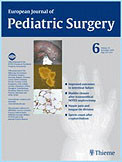Šnajdauf J, Rygl M, Petrů O, Kalousová J, Kuklová P, Mixa V, Keil R, Hříbal Z. Eur J Pediatr Surg. 2009 Dec;19(6):354–7. IF: 0.768

Abstract:
AIM OF STUDY: Aim of the study was to assess the complications and long-term results in children operated on for solid pseudopapillary tumor of the pancreas (SPTP) between 1993–2008 at the authors' institution with a focus on a novel duodenum-sparing technique to treat tumors of the head of the pancreas. METHODS: Retrospective analysis was performed of patient data including demographics, diagnostic measures, the operative technique focusing on tumor of the head of the pancreas, complications and long-term results. RESULTS: There were 13 patients (12 girls and one boy) with an average age of 14 years (9–17.5 years) at operation. In 7 patients the tumor was localized in the head of the pancreas, in 4 patients in the tail, and in 2 patients both the body and tail were involved. Patients with body and tail involvement underwent distal pancreatic resection. In 6 patients with head involvement a duodenum-sparing resection of the head and end-to-end anastomosis of the excluded jejunal loop either to the corpus or tail of the pancreas were performed. One girl underwent a modified Whipple operation. She developed a biliary fistula which closed after three weeks with endoscopic stenting. One patient with head resection developed a biliary fistula which closed after two weeks of stenting. One patient who underwent resection of the pancreatic head complained of recurrent abdominal pain one year postoperatively. All patients are alive without tumor recurrence at 6 months to 16 years after operation. CONCLUSION: SPTP is a rare pancreatic tumor with a low degree of malignancy. No perioperative chemotherapy is necessary. Therefore duodenal resection in cases of SPTP in the head of the gland seems too invasive and mutilating. The authors consider the duodenum-sparing technique to be more appropriate for the developing organism of a child. Favorable short and long-term results support this opinion.
-az-